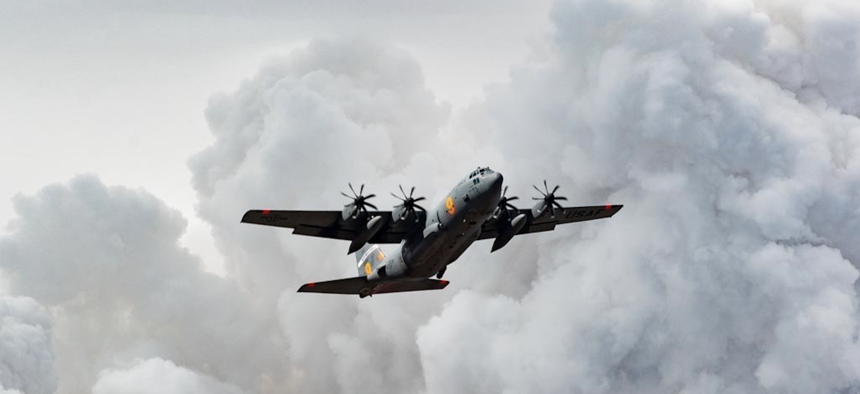Wildfires Are So Dangerous Now that the National Guard Prepares for Them Like Hurricanes

An Air National Guard C-130 flies over the plumes of smoke after dropping retardant on the Beckwourth Complex Fire, July 9, 2021 near Frenchman Lake in N. California. Air National Guard / Senior Master Sgt. Paula Macomber
For West Coast units, there’s no wildfire season anymore. ‘It’s really a fire year now,’ top general says.
The growing intensity of wildfire season on the West Coast has forced the National Guard to change the way it prepares aircraft and service members to fight those blazes, the service’s top general said Thursday.
In short: treat it like a hurricane, and model their approach after state guards across the southeast and Gulf Coast, who are used to back-to-back disasters, Chief of the National Guard Bureau Army Gen. Daniel Hokanson told reporters at the Pentagon on Thursday.
For example, in 2019, just months after Hurricane Michael and Florence killed almost 100 people, destroyed Tyndall Air Force Base in Florida, caused 134 buildings to be condemned at North Carolina’s Camp Lejeune, and caused billions of dollars in damage, National Guard members from aviation, sustainment, and maneuver brigades from those affected states gathered for an exercise drill and to build a response plan for the next storm.
The main questions: Who would be deployed? In 2019, North Carolina’s Guard needed help because about 4,000 of their service members were on orders to deploy overseas. How could neighboring state Guards backfill the vehicles, manpower, and aircraft that deployed units would take with them? Where would high-water vehicles or generators be prepositioned?
Earlier this year, various West Coast units mimicked that approach, Hokanson said. In a planning exercise at the National Interagency Fire Center in Boise, Idaho, the units drilled for wildfires. They realized that a California National Guard aviation brigade was deploying, “which took a lot of their aircraft” the state would need this wildfire season, the general said.
“So we looked around the country and identified all those states that could provide aircraft and crews,” Hokanson said. “Then we did everything we could to get them trained prior to fire season.”
For Army National Guard helicopter pilots, as Hokanson was when he fought fires as a UH-60 Black Hawk pilot in the Oregon National Guard, a lot of that training revolves around learning how to haul water from lakes to dump on fires.
“When you drop 5,000 pounds of water on a car, it will flatten it,” he said. “So you have got to be careful how you dump your water.”
This season is already worse than last year. Since January, wildfires in California have burned 228,000 acres, twice the amount destroyed during the same months in 2020. The still-burning Dixie fire is now the 13th-largest in California history. In Oregon, the state is battling the Bootleg fire, which has destroyed more than 413,000 acres and is the largest fire presently burning in the country.
Guard units from Idaho, Montana, and Arizona helped backfill California’s Guard. At present about 500 National Guard firefighters and 19 aircraft are supporting thousands of civilian firefighters fighting blazes. If civilian first-responder resources get exhausted, more National Guard troops will be called up, Hokanson said.
So far, the Guard has the resources to deal with this year’s wildfires. But they are watching unit readiness closely, Hokanson said, and that could change, depending on how long this year’s fire season runs.
“We used to talk about fire season,” Hokanson said. “It’s really a fire year now.”
NEXT STORY: Quick Hits






